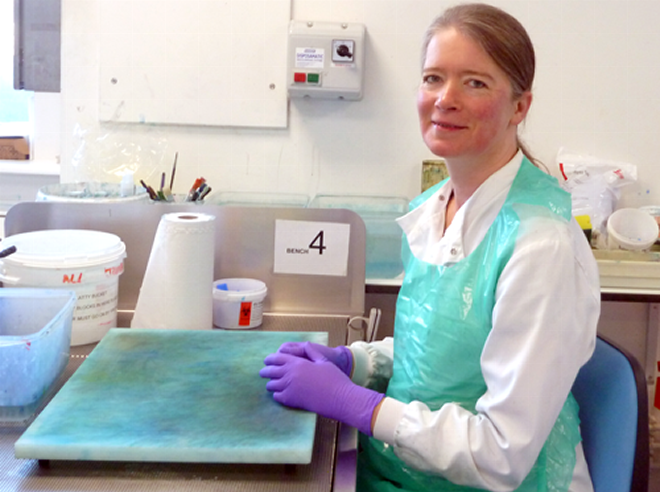Breast Cancer Awareness: the science and the symptoms

To support the campaign, we looked at the science involved in the testing and diagnosis of breast cancer by speaking to one of our members. We also spoke with Breast Cancer Care, a charity that offers support for breast cancer patients, who talked to us about managing symptoms of the disease.
Breast cancer is the most common type of cancer in the UK. It develops when cells in the breast start to grow in an uncontrolled way and form a tumour. As these tumours grow, they can spread to other parts of the body and become life-threatening. Symptoms can appear as a lump in the breast, an inverted nipple, a change in the shape or size of the breast, a swelling in the armpit, a rash on the nipple or a pain in the breasts that doesn’t go away.
It’s easy to dismiss these things as common aches and pains, but they can be serious symptoms. It is estimated that up to 12,000 women die of breast cancer in the UK each year. Fortunately, many of the women diagnosed survive, and now 3 out of 4 women are alive ten years later.
The ins and outs of breast cancer screening
From age fifty to seventy, women in the UK are offered breast screening by the NHS. The screening uses an x-ray test called a mammogram to check the breast for signs of cancer. This test can spot tiny cancers and the radiograph is reported by a radiologist. Most patients will have a normal result but when abnormalities appear, the expertise of a biomedical scientist is required.
Biomedical scientist Wendy Liptrot FIBMS said,
“If an abnormality is seen on the mammogram the patient usually has a biopsy which is reported by a pathologist. If this shows cancer, the tumour is excised either by mastectomy (whole breast) or wide local excision (part of the breast containing the tumour). This is where biomedical science comes in.
I examine, dissect and sample the mastectomy or wide local excision. The samples of tissue I take are processed in the lab and embedded in wax so that fine tissue sections can be taken. The tissue sections are mounted onto glass slides and stained with dyes.
The pathologist looks at the slides under the microscope to confirm the diagnosis of malignancy and also to determine the type, grade and stage of the tumour so that the patient’s treatment can be planned accordingly.”
The biomedical science behind breast cancer diagnosis
Wendy explained,
“As an Expert Practitioner in tissue dissection, my contribution to breast cancer diagnosis is to dissect and examine breast cancer excision specimens including mastectomies, wide local excisions and lymph node samples. My role is to provide the pathologist with all the information that they require to construct a diagnostic report of the patient’s tumour so that most appropriate treatment can be given.
The patient’s treatment depends upon accurate assessment of certain features of the tumour such as size, type, grade, distance from excision margins and tumour spread to lymph nodes. My responsibility is to select the most appropriate samples of tissue that will allow the pathologist to assess these features under the microscope.
Accuracy at the dissection stage is important as it is the dissector who determines what samples of the original specimen are made available for the pathologist to report upon. Errors at this stage can ultimately affect patient treatment. The responsibility that I feel for the tissue that I examine makes my job both challenging and rewarding.”
However, following breast cancer treatment, many women face long-term emotional and physical issues and need support as a result. UK-wide charity Breast Cancer Care offers a variety of services, including a helpline, an end-of-treatment support app (BECCA) and face-to-face group support to help women adapt to life after the disease.
Dr Emma Pennery, Clinical Director at Breast Cancer Care said,
“Every day we hear from women who find the end of breast cancer treatment one of the hardest parts. Many face lasting anxiety about the cancer coming back, debilitating fatigue, and damaged body confidence, all of which can severely impact their ability to get back to daily life.
“We know how important it is to care for people’s minds as well as bodies, so Breast Cancer Care offers a variety of support services designed to help women move forward after breast cancer, physically and emotionally.
We provide support on anything from healthy eating and getting back to exercise, to managing long-term side effects like menopausal symptoms, pain or lymphoedema. Our face-to-face and online support provides a vital opportunity for women to share with others going through similar things.
“Anyone looking for support and information after a breast cancer diagnosis can call Breast Cancer Care’s expert nurses on 0808 800 6000 or visit www.breastcancercare.org.uk to find out more.”
In addition to the charities and professional bodies raising awareness of breast cancer, this month also saw the NHS Twitter account taken over by Kris, a stage 4 breast cancer patient who shared her experience of being diagnosed in her twenties.
Whilst the risk of developing breast cancer increases as you age, most women diagnosed with breast cancer do not have a family history of the disease, so paying attention to your body’s aches and pains are important. We hope to raise awareness of how important it is to go to a GP and get tested if you experience strange or abnormal symptoms in the breast, no matter how old you are.
